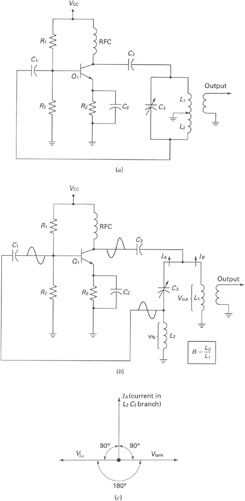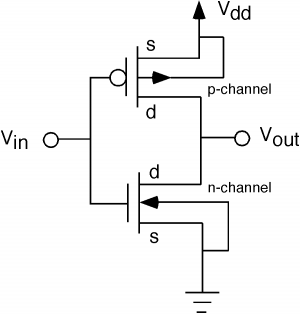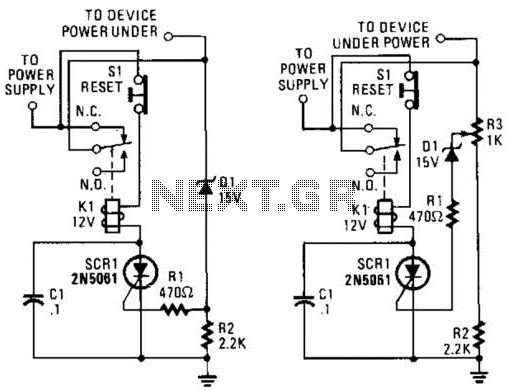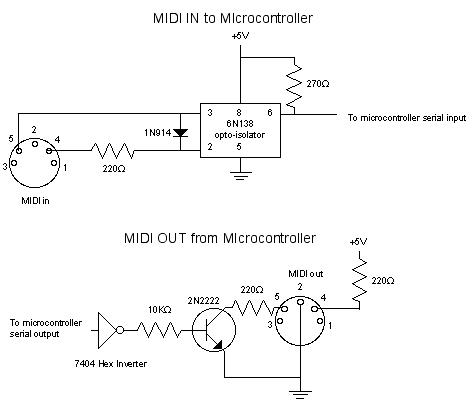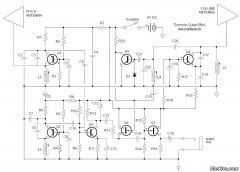
Crystal-Oscillator Circuits
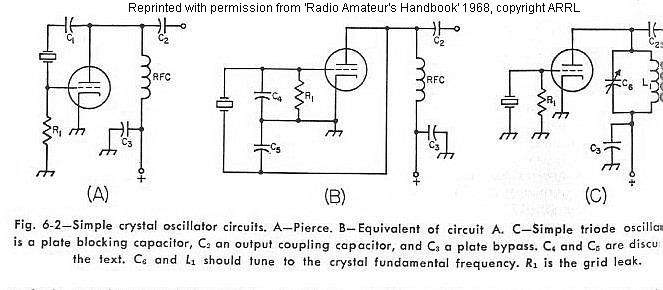
The frequency of a crystal-controlled oscillator is maintained with high precision through the use of a quartz crystal. The frequency is primarily determined by the dimensions of the crystal, particularly its thickness, while other circuit parameters have minimal impact. However, the power that can be achieved is limited by the heat tolerance of the crystal. The heating effect is influenced by the radio frequency (RF) crystal current, which is dependent on the feedback required for adequate excitation. Excessive heating can lead to frequency drift, which varies based on the crystal's cut. Therefore, excitation should be minimized to the necessary level for optimal operation. The simplest crystal oscillator circuit is depicted in Fig. 6-2A, with an equivalent circuit in Fig. 6-2B, where C4 represents the grid-cathode capacitance and C5 denotes the plate-cathode or output capacitance. The ratio of these capacitors regulates the oscillator's excitation, and best practices recommend adding external capacitors to enhance excitation control. The circuit in Fig. 6-2C represents a tuned-grid tuned-plate circuit, with the crystal substituting the tuned grid circuit. The most prevalent crystal oscillator circuits are based on these two fundamental types, illustrated in Fig. 6-3. Although these circuits are relatively more complex, they integrate the functions of an oscillator and an amplifier or frequency multiplier within a single tube. In all configurations, the screen of the tetrode or pentode serves as the plate in a triode oscillator, with power output derived from a separate tuned tank circuit within the plate circuit. While the oscillator is not entirely independent of the adjustments made in the plate tank circuit when near the crystal's fundamental frequency, the effects can be effectively minimized by selecting the appropriate oscillator tube. The circuit shown in Fig. 6-3 is referred to as the Tritet. The oscillator circuit corresponds to that of Fig. 6-2C, with excitation controlled by adjusting L1C1, which should have a low L/C ratio and be tuned significantly to the high-frequency side of the crystal frequency (approximately 5 MHz for a 3.5 MHz crystal) to avoid over-excitation and excessive crystal current. Once the optimal adjustment for average crystals is established, C1 can be replaced with a fixed capacitor of the same value. The oscillator in the grid-plate circuit of Fig. 6-3C mirrors that of Fig. 6-3B, with the ground point shifted from the cathode to the plate of the oscillator (specifically, to the tube's screen). Excitation is adjusted through the appropriate proportions of C6 and C7. In most tube types used in the circuits of Fig. 6-3, oscillation ceases when the output plate circuit is tuned to the crystal frequency, necessitating operation with the plate tank circuit critically detuned for maximum output stability. However, when using the 6AG7, 5763, or the lower-power 6AH6 tubes with proper excitation adjustment, it is feasible to tune to the crystal frequency without halting oscillation. The plate tuning characteristic should resemble that shown in Fig. 6-4. These tubes also operate with less crystal current than most other types for a given power output, resulting in less frequency variation when the plate circuit is tuned through the crystal frequency (less than 25 cycles at 3.5 MHz). Crystal current can be estimated by observing the brightness of a 60 mA dial lamp connected in series with the crystal. Current should be minimized for satisfactory output through careful excitation adjustment. With the specified operating voltages, satisfactory output is achievable with the crystal.
The crystal-controlled oscillator is a critical component in various electronic applications, providing stable frequency generation essential for communication systems, signal processing, and timing circuits. The design typically involves a feedback mechanism that utilizes the properties of the quartz crystal to maintain oscillation at a specific frequency. The oscillator circuit's stability and performance can be influenced by various factors, including the choice of active components, the configuration of the feedback network, and the quality of the crystal itself.
In practical implementations, the oscillator may be designed to operate within specific frequency ranges, necessitating careful selection of passive components such as capacitors and inductors to achieve the desired tuning characteristics. The use of external capacitors, as mentioned, enhances the control over excitation levels and overall circuit performance. Additionally, the integration of amplifying stages can significantly improve output power, allowing the oscillator to drive larger loads or interface with subsequent circuit stages effectively.
Thermal management is also an important consideration in the design of crystal oscillators. Excessive heating can lead to frequency instability and potential damage to the crystal. Therefore, implementing feedback mechanisms that minimize crystal current while maintaining sufficient excitation for stable oscillation is crucial. This balance can be achieved through careful circuit design, including the use of variable resistors or capacitors to fine-tune the excitation levels dynamically.
Overall, crystal-controlled oscillators represent a foundational technology in electronics, with their precise frequency control enabling advancements across various fields, including telecommunications, instrumentation, and consumer electronics. Proper understanding and implementation of these circuits are essential for engineers and designers aiming to create reliable and efficient electronic systems.The frequency of a crystal-controlled oscillator is held constant to a high degree of accuracy by the use of a quartz crystal. The frequency depends almost entirely on the dimensions of the crystal (essentially its thickness); other circuit values have comparatively negligible effect.
However, the power obtainable is limited by the heat the crysta l will stand without fracturing. The amount of heating is dependent upon the r. f. crystal current which, in turn, is a function of the amount of feedback required to provide proper excitation. Crystal heating short of the danger point results in frequency drift to an extent depending upon the way the crystal is cut.
Excitation should always be adjusted to the minimum necessary for proper operation. The simplest crystal-oscillator circuit is shown in Fig. 6-2A. An equivalent circuit is shown in Fig. 6-2B. , where C4 represents the grid -cathode capacitance and C5 indicates the plate-cathode, or output capacitance. The ratio of these capacitors controls the excitation for the oscillator, and good practice generally requires that both of these capacitances be augmented by external capacitors, to provide better control of the excitation.
The circuit shown in Fig. 6-2C is the equivalent of the tuned-grid tuned-plate circuit discussed in the chapter on vacuum-tube principles, the crystal replacing the tuned grid circuit. The most commonly used crystal-oscillator circuits are based on one or the other of these two simple types, and are shown in Fig.
6-3. Although these circuits are somewhat more complicated, they combine the functions of oscillator and amplifier or frequency multiplier in a single tube. In all of these circuits, the screen of the tetrode or pentode is used as the plate in a triode oscillator.
Power output is taken from a separate tuned tank circuit in the actual plate circuit. Although the oscillator itself is not entirely independent of adjustments made in the plate tank circuit when the latter is tuned near the fundamental frequency of the crystal, the effects can be satisfactorily minimized by proper choice of the oscillator tube. The circuit of Fig. 6-3 is known as the Tritet. The oscillator circuit is that of Fig. 6-2C. Excitation is controlled by adjustment of the L1C1, which should have a low L/C ratio, and be tuned considerably to the high-frequency side of the crystal frequency (approximately 5-Mc.
for a 3. 5-Mc. crystal) to prevent over-excitation and high crystal current. Once the proper adjustment for average crystals has been found, C1 may be replaced with a fixed capacitor of equal value. The oscillator of the grid-plate circuit of Fig. 6-3C is the same as that of Fig. 6-3B, except that the ground point has been moved from the cathode to the plate of the oscillator (in other words, to the screen of the tube).
Excitation is adjusted by proper proportioning of C6 and C7. When most types of tubes are used in the circuits of Fig. 6-3, oscillation will stop when the output plate circuit is tuned to the crystal frequency, and it is necessary to operate with the plate tank circuit critically detuned for maximum output with stability. However, when the 6AG7, 5763, or the lower-power 6AH6 is used with proper adjustment of excitation, it is possible to tune to the crystal frequency without stopping oscillation.
The plate tuning characteristic should then be similar to Fig. 6-4. These tubes also operate with less crystal current than most other types for a given power output, and less frequency change occurs when the plate circuit is tuned through the crystal frequency (less than 25 cycles at 3. 5 Mc. ). Crystal current may be estimated by observing the relative brilliance of a 60-ma. dial lamp connected in series with the crystal. Current should be held to a minimum for satisfactory output by careful adjustment of excitation. With the operating voltages shown, satisfactory output should be obtained with cry 🔗 External reference
The crystal-controlled oscillator is a critical component in various electronic applications, providing stable frequency generation essential for communication systems, signal processing, and timing circuits. The design typically involves a feedback mechanism that utilizes the properties of the quartz crystal to maintain oscillation at a specific frequency. The oscillator circuit's stability and performance can be influenced by various factors, including the choice of active components, the configuration of the feedback network, and the quality of the crystal itself.
In practical implementations, the oscillator may be designed to operate within specific frequency ranges, necessitating careful selection of passive components such as capacitors and inductors to achieve the desired tuning characteristics. The use of external capacitors, as mentioned, enhances the control over excitation levels and overall circuit performance. Additionally, the integration of amplifying stages can significantly improve output power, allowing the oscillator to drive larger loads or interface with subsequent circuit stages effectively.
Thermal management is also an important consideration in the design of crystal oscillators. Excessive heating can lead to frequency instability and potential damage to the crystal. Therefore, implementing feedback mechanisms that minimize crystal current while maintaining sufficient excitation for stable oscillation is crucial. This balance can be achieved through careful circuit design, including the use of variable resistors or capacitors to fine-tune the excitation levels dynamically.
Overall, crystal-controlled oscillators represent a foundational technology in electronics, with their precise frequency control enabling advancements across various fields, including telecommunications, instrumentation, and consumer electronics. Proper understanding and implementation of these circuits are essential for engineers and designers aiming to create reliable and efficient electronic systems.The frequency of a crystal-controlled oscillator is held constant to a high degree of accuracy by the use of a quartz crystal. The frequency depends almost entirely on the dimensions of the crystal (essentially its thickness); other circuit values have comparatively negligible effect.
However, the power obtainable is limited by the heat the crysta l will stand without fracturing. The amount of heating is dependent upon the r. f. crystal current which, in turn, is a function of the amount of feedback required to provide proper excitation. Crystal heating short of the danger point results in frequency drift to an extent depending upon the way the crystal is cut.
Excitation should always be adjusted to the minimum necessary for proper operation. The simplest crystal-oscillator circuit is shown in Fig. 6-2A. An equivalent circuit is shown in Fig. 6-2B. , where C4 represents the grid -cathode capacitance and C5 indicates the plate-cathode, or output capacitance. The ratio of these capacitors controls the excitation for the oscillator, and good practice generally requires that both of these capacitances be augmented by external capacitors, to provide better control of the excitation.
The circuit shown in Fig. 6-2C is the equivalent of the tuned-grid tuned-plate circuit discussed in the chapter on vacuum-tube principles, the crystal replacing the tuned grid circuit. The most commonly used crystal-oscillator circuits are based on one or the other of these two simple types, and are shown in Fig.
6-3. Although these circuits are somewhat more complicated, they combine the functions of oscillator and amplifier or frequency multiplier in a single tube. In all of these circuits, the screen of the tetrode or pentode is used as the plate in a triode oscillator.
Power output is taken from a separate tuned tank circuit in the actual plate circuit. Although the oscillator itself is not entirely independent of adjustments made in the plate tank circuit when the latter is tuned near the fundamental frequency of the crystal, the effects can be satisfactorily minimized by proper choice of the oscillator tube. The circuit of Fig. 6-3 is known as the Tritet. The oscillator circuit is that of Fig. 6-2C. Excitation is controlled by adjustment of the L1C1, which should have a low L/C ratio, and be tuned considerably to the high-frequency side of the crystal frequency (approximately 5-Mc.
for a 3. 5-Mc. crystal) to prevent over-excitation and high crystal current. Once the proper adjustment for average crystals has been found, C1 may be replaced with a fixed capacitor of equal value. The oscillator of the grid-plate circuit of Fig. 6-3C is the same as that of Fig. 6-3B, except that the ground point has been moved from the cathode to the plate of the oscillator (in other words, to the screen of the tube).
Excitation is adjusted by proper proportioning of C6 and C7. When most types of tubes are used in the circuits of Fig. 6-3, oscillation will stop when the output plate circuit is tuned to the crystal frequency, and it is necessary to operate with the plate tank circuit critically detuned for maximum output with stability. However, when the 6AG7, 5763, or the lower-power 6AH6 is used with proper adjustment of excitation, it is possible to tune to the crystal frequency without stopping oscillation.
The plate tuning characteristic should then be similar to Fig. 6-4. These tubes also operate with less crystal current than most other types for a given power output, and less frequency change occurs when the plate circuit is tuned through the crystal frequency (less than 25 cycles at 3. 5 Mc. ). Crystal current may be estimated by observing the relative brilliance of a 60-ma. dial lamp connected in series with the crystal. Current should be held to a minimum for satisfactory output by careful adjustment of excitation. With the operating voltages shown, satisfactory output should be obtained with cry 🔗 External reference
